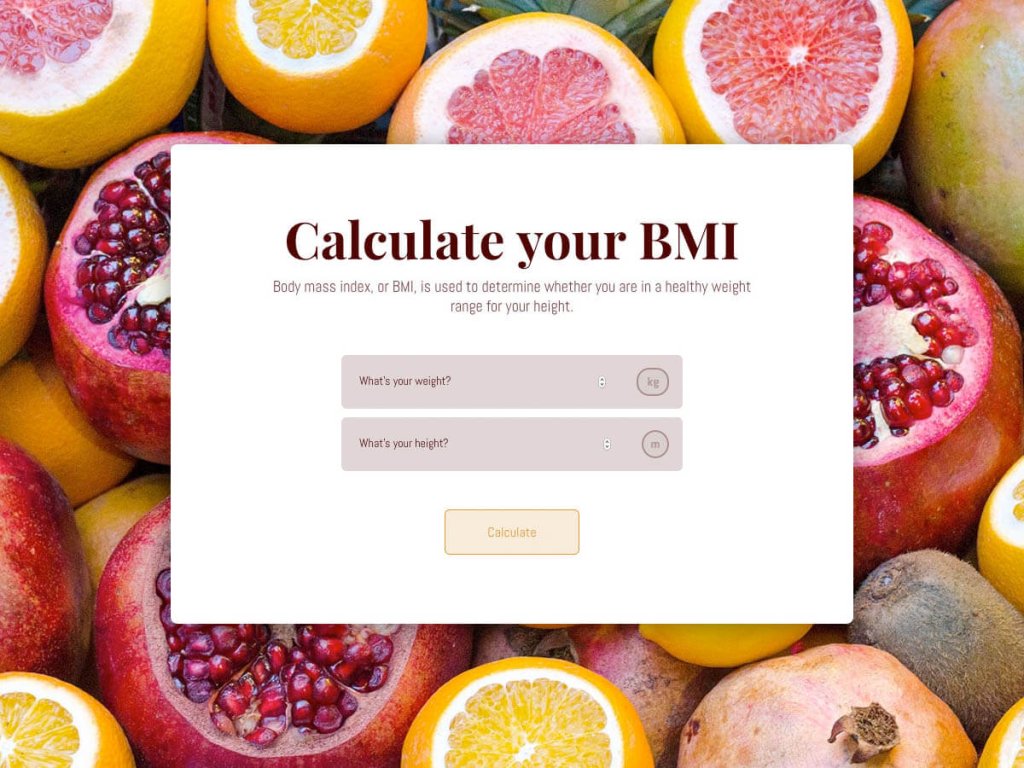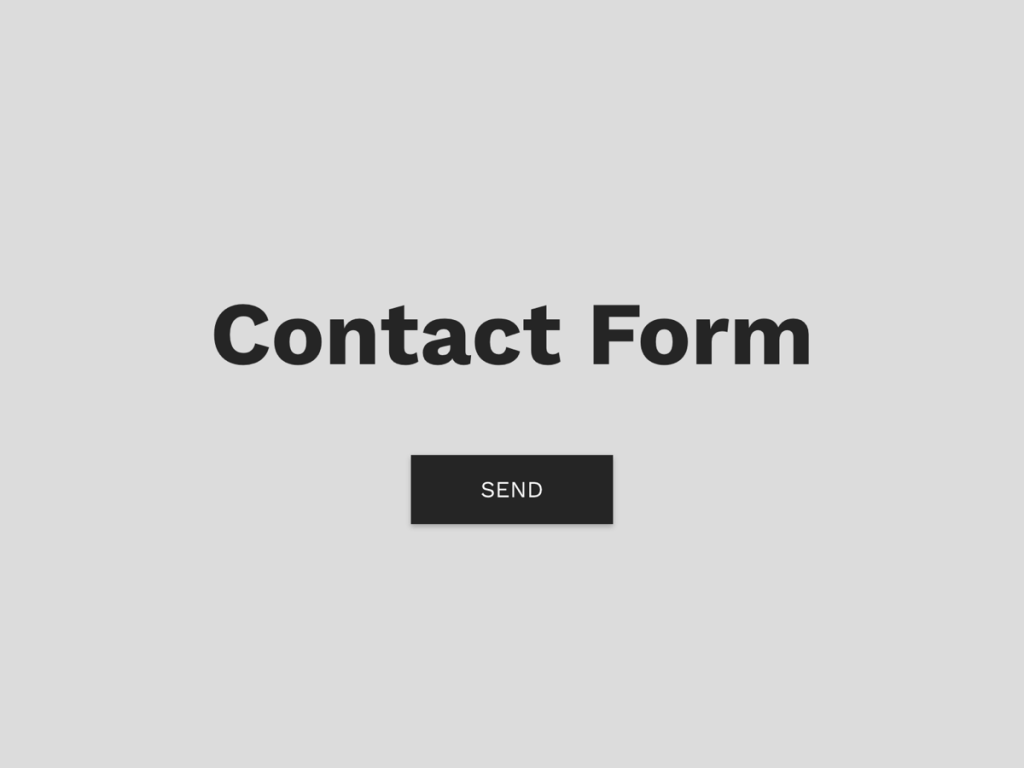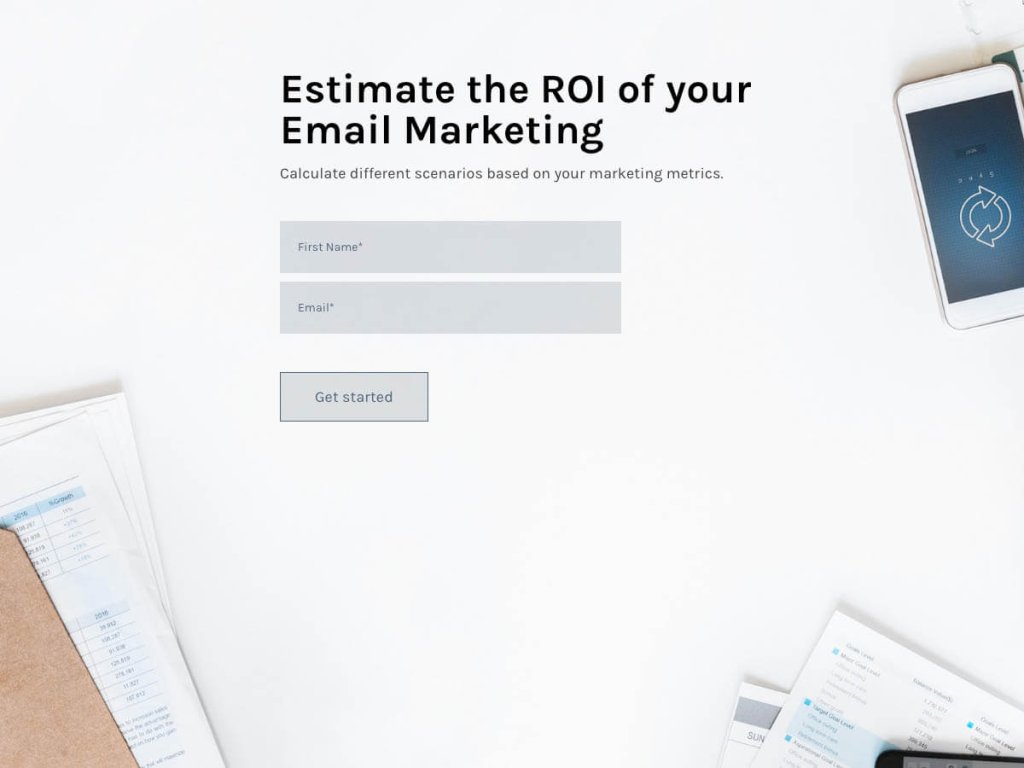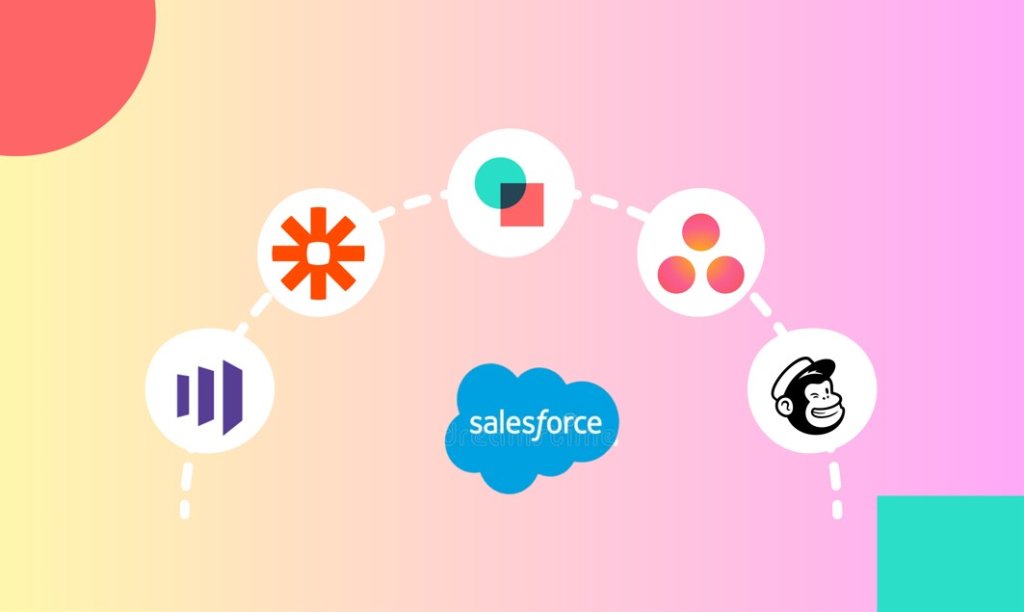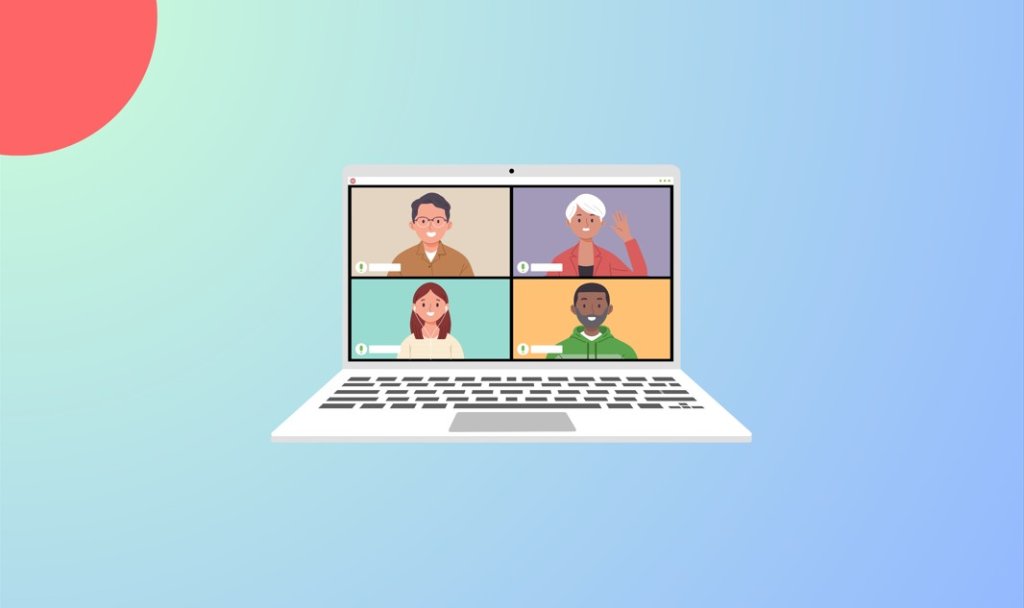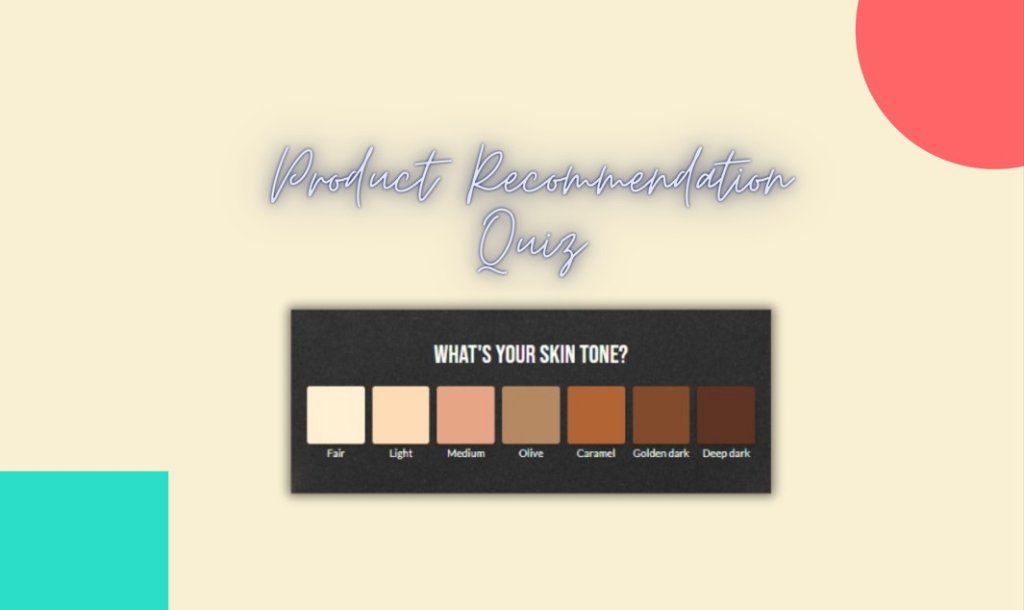Content distribution can be a confusing process, especially when you're trying to figure out what type of content is best for which channel. The truth is that there is no one-size-fits-all approach to content distribution. You'll need to tailor your strategy depending on the audience you want to reach and the goals behind your content marketing efforts.
In this article, we'll break down each type of content distribution (owned, earned, paid) by outlining the pros and cons of each channel. We’ll also give you some tips for choosing which channels are right for your business based on who you want to reach and what kind of message you want to send them.
Content Types for Distribution
The following are three types of content that cover all content pieces you may find out there. Each type has advantages and disadvantages. A healthy mix will ensure good visibility.
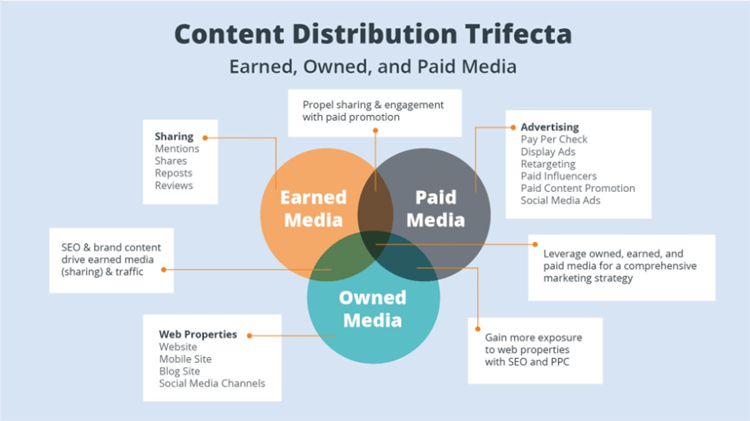
Owned Content:
✓ The content you own or have the most control over and include your website and social media profiles. This is usually original content in the form of articles, interactive content elements such as quizzes, surveys, tests etc, infographics, videos, images etc.
✓ The main advantage of owned channels is that they're easy to measure for analytics and conversions. Additionally, you have much more control over what you publish and how.
✓ The main disadvantage is that they can be rather limited in reach and audience. It may take a great deal of effort to turn owned channels into a sustainable channel for business growth.
Earned Content:
✓ Earned channels of content involve a third party.
✓ Examples could be guest posting on someone else's blog, an article published in an industry publication, or a mention on another blogger's social media feed.
✓ Sometimes, but not always, you can influence what message the audience gets from that third-party source. Sometimes, you will have no influence over what was published and it may even be negative.
Paid Content:
Usually the easiest of the three types to access, but has limitations. Most common types of paid distribution include:
✓ placing sponsored posts on other websites or blogs
✓ buying ads on social media sites such as Facebook and Twitter
✓ purchasing promoted tweets or pins on Pinterest
✓ using ad words on search engines like Google.
So now we know what kind of content types are there, but the question is, how can you spread the word effectively to get more people to know about your content and invite them to interact with it.
The Benefits of a Content Distribution Strategy
It's easy to think of content distribution as simply promoting your blog posts on social media, guest posting on websites in your niche, or running a series of online advertisements. But there are deeper benefits to building an effective content distribution strategy that goes beyond the numbers and into customer loyalty.
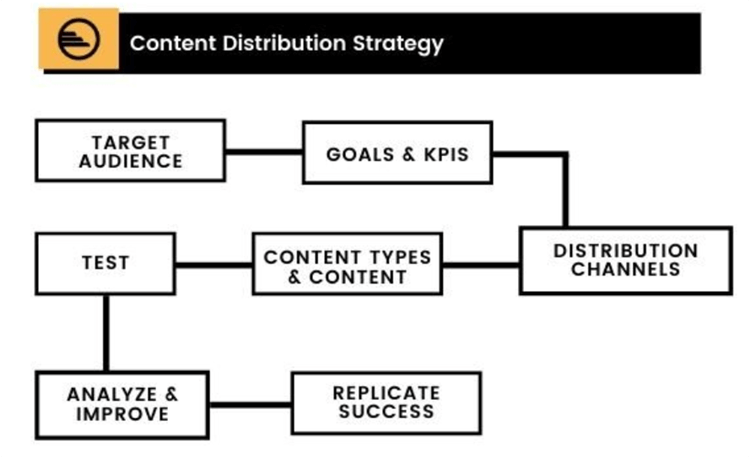
Content distribution is all about getting your message out there so that the relevant people can learn about you and trust you; it's not just about driving site traffic. Ideally, you should be providing your audience with a complete digital experience.
Consider some of the following benefits of a proper content distribution strategy:
✓ High engagement from customers through forums and social media channels
✓ Higher rankings in search engine results
✓ Exposure to new audiences through guest posts or contributing articles/videos to other businesses
✓ Increased credibility through guest blogging (beyond just being another company trying to sell something)
✓ More links back to your website (especially if you do guest blogging as a part of your strategy)
Let's dive deeper into a couple of these benefits:
1. More Traffic and Higher Engagement
Depending on which type of content you're distributing, you'll gain additional benefits in the form of traffic.
As mentioned previously, if your goal is to just drive traffic to your website via social media and other online channels, that's probably not going to accomplish much for your business goals. What’s worse, tactics like link bait might even hurt you in the long run because they're often low quality and don't build trust with customers or target audiences.
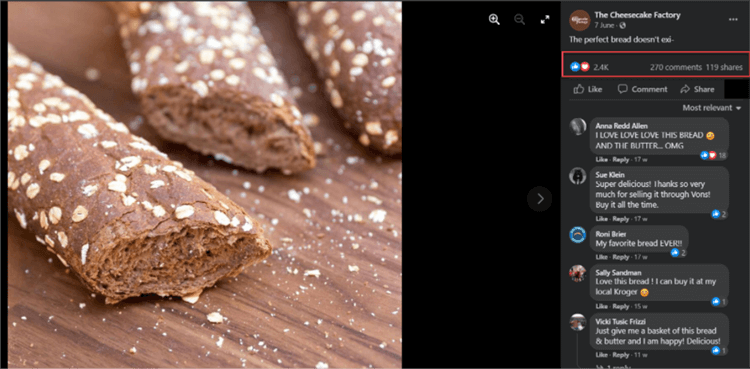
In the screenshot above, you can see the commonly used phrase “The perfect X doesn’t exist..” being used to generate engagement within this target audience.
With almost two and a half thousand likes, close to three hundred comments and more than a hundred shares, one could say that this simple post had the desired effect in terms of getting people to engage with it.
This is the type of content that generates traffic and makes people want to know more about what a business is all about.
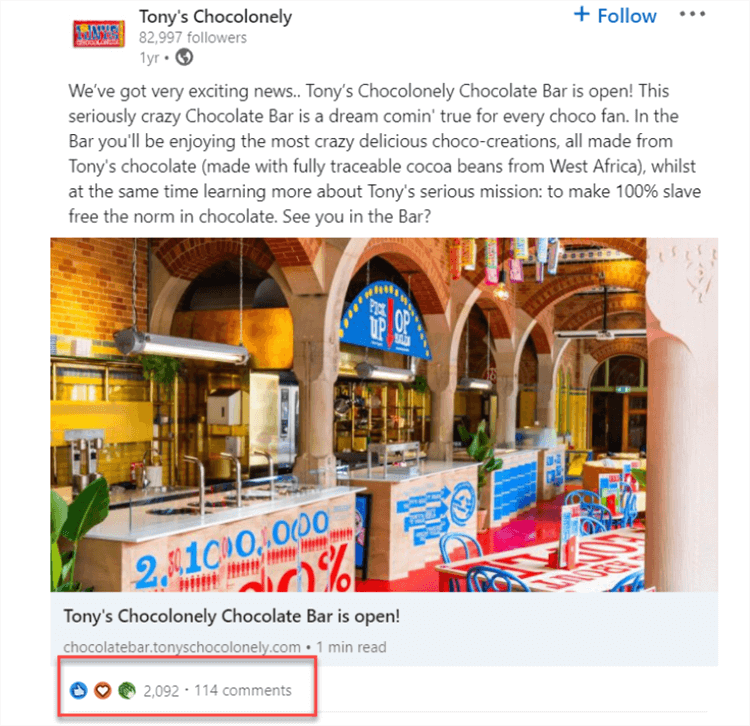
Another example can be seen here on Linkedin, with huge engagement in terms of reactions and comments.
Looking deeper at the comments, one can see that people are engaging by sharing their opinion, tagging other people in the comments, and asking other connections when they should visit this place.
If your goal is to get people interested in what you have to say (and therefore potentially buy from you), then leveraging distribution channels within your overall content marketing strategy will help bring more visitors back to your site when they click through after reading one of these articles or videos.
With that said, a lot can and should be done on your website to give visitors a reason to stick around. If content distribution is one way you're pulling in new people, there's no argument that those first few pages of your blog need to be strong enough to retain them as readers and potential customers.
In addition to owning your channels (website, social media accounts, etc.), you must take advantage of the "earned" channels out there for distributing your content and build relationships with influencers who can help spread your message further.
Follow these steps to get more traffic to your content:
# Perform Keyword Research
By doing keyword research correctly, you can create content that will be highly targeted toward the topic your product is in. If you can rank for keywords related to topics within your product or service, then search engines have signals that these pages are well-optimized and likely relevant for searchers in this area.
Use tools such as Ahrefs and SEMRush to find the right keywords to target.
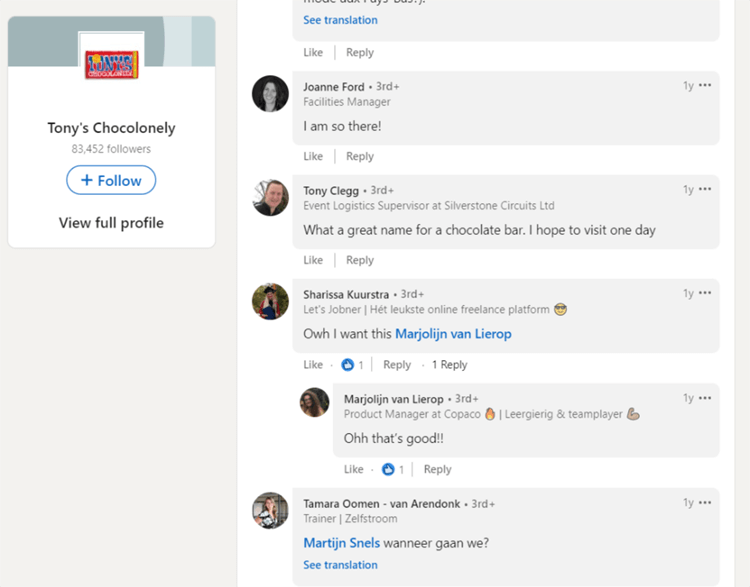
# Evaluate Content Performance
Once you've created content it's important to find out how well it is performing for you in terms of traffic and shares. You want to track your content over time and see how it changes in performance so you can find out if your content is valuable to your company and customers.
Using social media tools such as TweetDeck, HootSuite, or Sprout Social to measure the performance of your content on social channels.
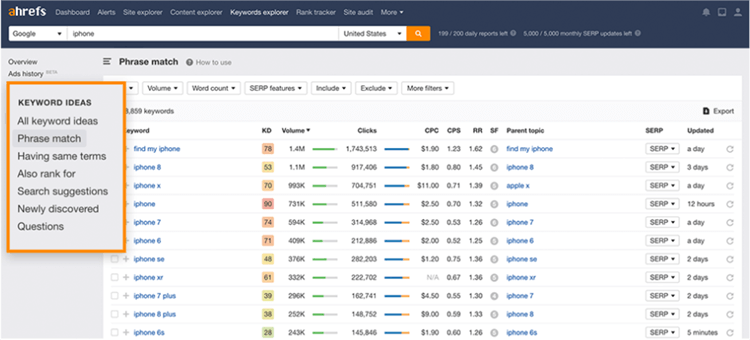
# Create a Helpful Industry Tool or Content Resource
A great way to engage your audience and drive traffic to your site is by creating a helpful tool or resource for industry professionals. With the rise of content marketing, it's become more common for companies to create tools to help simplify a process within their industry.
Neil Patel’s backlink checker is a great example of a tool that keeps people coming back to it, driving more traffic to his website and content.
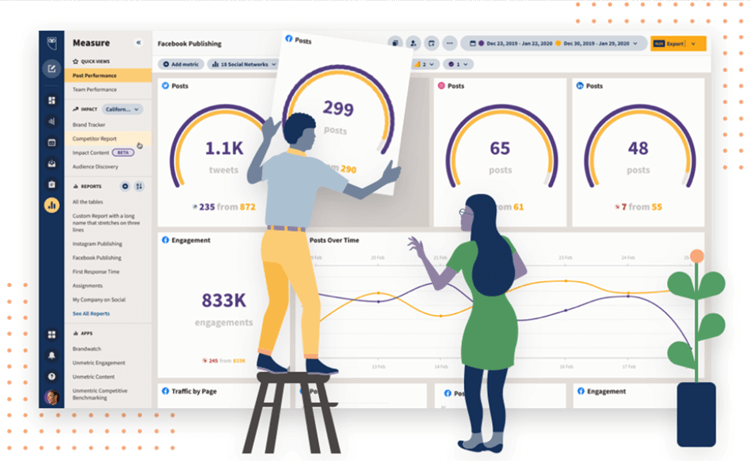
2. Build Up a Loyal Audience
There are several benefits to building an audience and getting your content out there - whether it's online or offline. No matter what type of content you're distributing (owned, earned, paid), the main goal is typically to build credibility in your industry by showing people that you know about their problems and have solutions for them.
The more connections you make with potential customers and higher-ranking brands in your niche, the more likely they'll consider you for future business opportunities such as partnerships or even turning into a customer yourself someday.
Creating a meaningful connection with someone on social media isn't always easy but if you offer genuinely helpful advice on articles and blog posts they share, connect over Twitter when they retweet one of your articles or start a conversation on LinkedIn, you'll likely make a lasting impression.
The steps to build your audience are:
Research your industry's top brands, influencers, and publications to determine who might be interested in sharing or mentioning your content. See what types of articles they share on social media to help you determine which platforms you should focus on.
Determine the "why" - Why would these brands want to connect with you? What do you bring to the conversation? What makes you trustworthy and credible enough to consider for future business opportunities?
Make it easy - Find out what they care about so you can offer them something relevant to their interests. Determine your USP (unique selling proposition) that sets you apart from everyone else.
Share great content - If they share a few of your posts on social media, reply to their comments and start a conversation over email. Build a relationship by offering valuable advice in each piece of content you create instead of being pushy.
Track results - Analyze which brands you're connected with so you can shift your attention towards the ones that respond best to your content over time.
3. Better Rankings in Search Engine Results
When people read through content that is relevant to them and aligned with their interests, they're more apt to share it with others who may also be interested. In theory, this means more links back to your website when someone reads an article about you from another source and wants to share the love (in addition to the potential traffic).
If you have good information that genuinely helps other businesses or professionals solve problems, you're more likely to get a positive response from your audience.
The key here is to find the right balance between creating content that will be shared and not becoming spammy yourself. Understanding how other people's audiences are interacting with specific types of content online can help shape your strategy, too.
If most viral stories on similar websites to yours include 1-3 images, for instance, it might be best to consider adding appropriate visual elements to your blog posts or articles so people are more apt to share them that way.
To get better rankings in search engines, follow these steps:
✓ Create a spreadsheet with the top 100 search terms related to your website or blog topic.
✓ Consider keywords that have a decent search volume with a low competition level, which is an easier way to get your site ranked faster in search engines.
✓ Create content around these topics and continue to add fresh new material.
✓ Include links from relevant sites into online articles or blog posts you've written, so they'll rank higher in search engines for your keywords.
✓ Create a unique, attention-getting title that includes your keyword at the beginning of the title. Headlines that have a number or strong word in them will get more attention on social media networks, where people love lists and items numbered.
✓ Make sure that the links you share direct people to relevant pages on your site, and write enticing descriptions for social media networks.
✓ Build links from other sites and use keywords in the link text.
4. Increase the ROI of Your Content
Creating a solid strategy for distributing your content will help you get more value out of the time and money you put into creating it.
Content doesn't have to be overly expensive or elaborate to build an audience and start bringing in new customers, but if you spend a lot of time but no one is there to see it, isn't that time wasted? If you're feeling bogged down by what type of distribution works best with what type of content, take a look at how others are working with their platforms.
The goal here is not only to create something good, but also something that can make people remember your brand in a positive light. In fact, there are also various branding tools that you can consider in this regard. These tools can help increase the return you get on the content that you produce.
To increase the ROI of your content, these are the steps to follow:
Identify your audience & build relationships with them
Define goals for your content distribution
A/B test your content to find what works best for you
Tailor platforms to suit the needs of specific content types
Now that we saw some of the clear benefits of a well designed content distribution strategy, let's see how such strategy can be created.
How to Create a Content Distribution Strategy
Follow this step-by-step guide to make a solid strategy for distributing your content:
1. Research Your Target Audience & Check Your Content’s Relevancy
If you're distributing your content to attract new customers or build awareness, the first step is to find out who they are and what interests them. Take a look at how other businesses in your industry are attracting their audiences - which means there's more likely to be someone there for you as well.
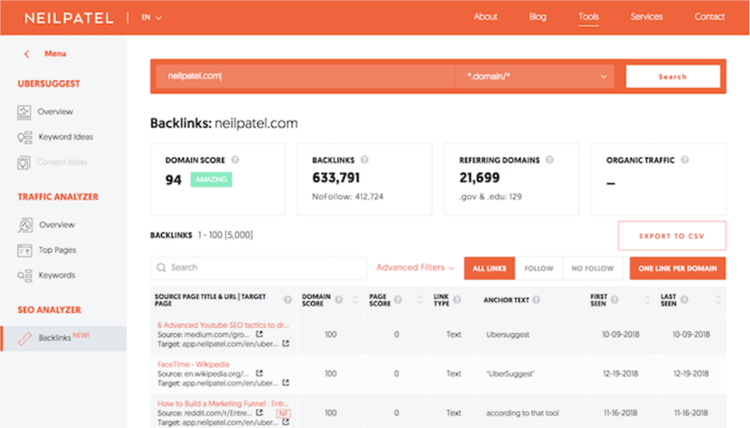
In some industries writing an eBook or recording an audio book is how competitors are attracting the right target audience. Take note of the common ways that authority is established and use these ways in your business.
Establishing yourself as an expert in your niche can also help ease people into trusting your brand if they see that you know about their problems and helping them solve them. Use this information when developing relevant content based on audience needs.
Once you have a general idea of who you're talking to and what they want, check your content standards by asking the question, “Am I adding value by solving their problems with my content?”
2. Choose Your Sales Channels for Content
Each type of content has its way of giving you a return on investment (ROI). For instance, blogging is as great way to create high-quality written content that can be revisited months or even years later for new readers who may not have seen it before.
On the other hand, Twitter and Facebook are good mediums for distributing short, relevant messages that encourage people to click the web link in your bio to learn more.
You might also consider using paid advertising as an option - this is usually used to connect with specific audiences within a very specific timeframe (such as right after launching a new product) but can still help attract your ideal customers and get them interested enough in what you're selling.
Using these channels strategically will help you not only attract the right people to your business, but they'll also begin trusting your brand more quickly. This will only happen if they feel like they're getting value out of what you share with them.
A couple of questions to ask here are:
? How often should you post content?
? Is it best to schedule posts in advance and keep them regularly coming, or just do it when something new comes up?
These answers will differ based on the type of distribution channel you're using. For instance, if you have a blog that's already attracting readers pretty well, posting more frequently might not be as beneficial as having regular quality over quantity.
However, if you want to build an audience from scratch with your social media presence, then setting aside a specific time each day (or even multiple times for each platform) where you focus specifically on getting and sharing relevant content is a good way to start gaining traction.
There are various types of content formats that can be used in omni-channel marketing to drive people to your sales funnel. Let’s have a look at some of the best ones to consider.
Long-Form Blog Posts:
✓ These are articles that last several thousand words.
✓ They are usually the most in-depth and valuable kinds of content available to audiences.
✓ They can also be converted into eBooks, guides, or white papers and generally go deeper than anything else you can create online.
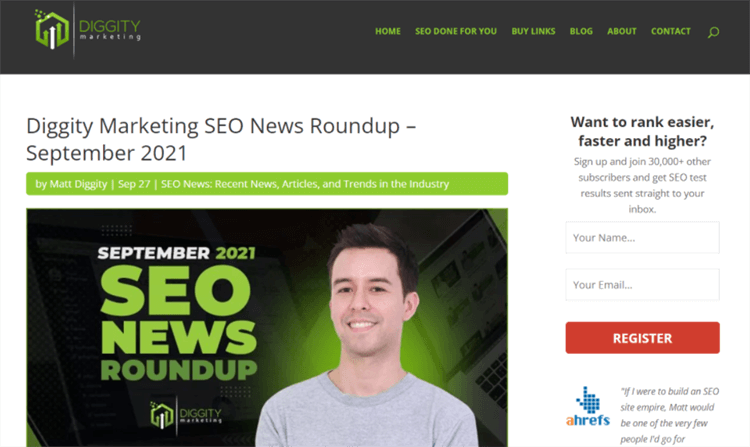
Industry Reports:
✓ Hybrid between long-form posts and shorter content
✓ A great way to gather in-depth data, present it as an infographic or table
✓ Allows you to take portions of that information and use them in blog posts.
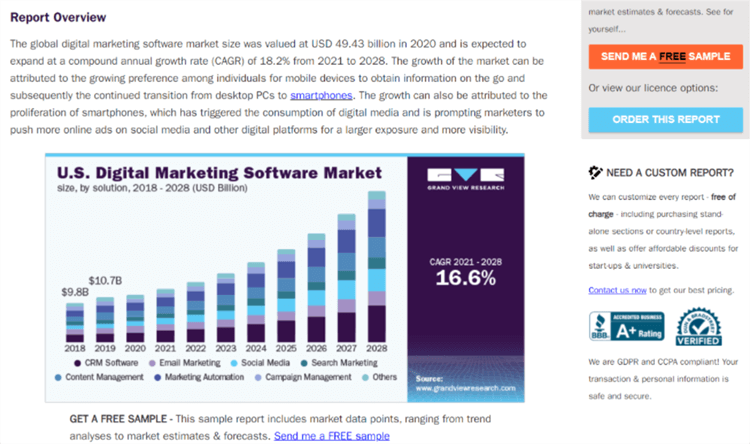
Long-Form Videos:
✓ Many marketers have moved away from long-form content and are focusing on video instead
✓ Case studies, webinars, and instructional videos are all long-form formats.
✓ These can be used as stand-alone videos on your homepage or through social media channels.
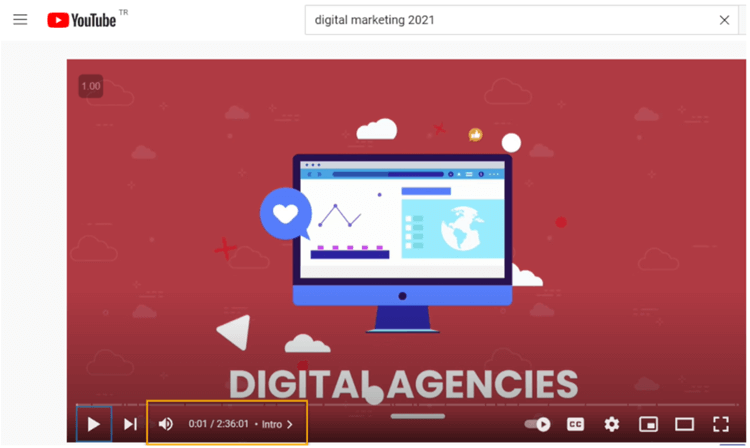
EBooks:
✓ Still hot on Amazon, eBooks have made their way into companies’ digital marketing strategy as well.
✓ Can be used to directly sell and convert website visitors into customers with collections of post excerpts or links attached to resources within the eBook.
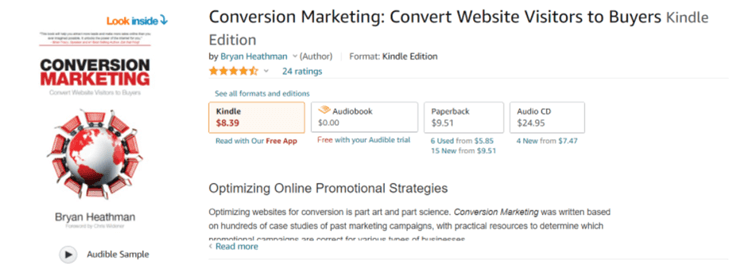
Long-Form Podcasts:
✓ People like the real authenticity that hosting a podcast offers.
✓ For example, it could be worth your while to record yourself reading an article converted into a podcast
✓ This recording can then be used in multiple ways.
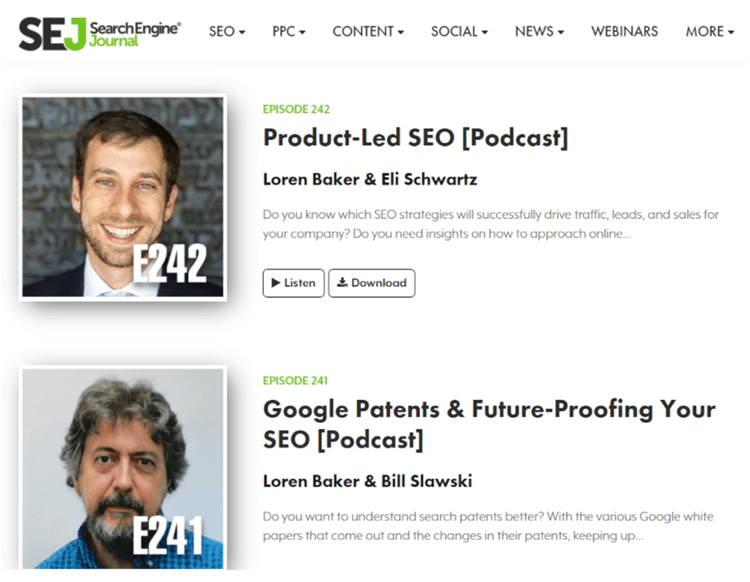
Infographics:
✓ A well-made infographic can be a wonderful source for others to link to and spread the word about it, even further.
✓ The single most important thing about creating good infographics is to make sure they are useful
✓ Also, use them to relay facts that your audience is interested in.
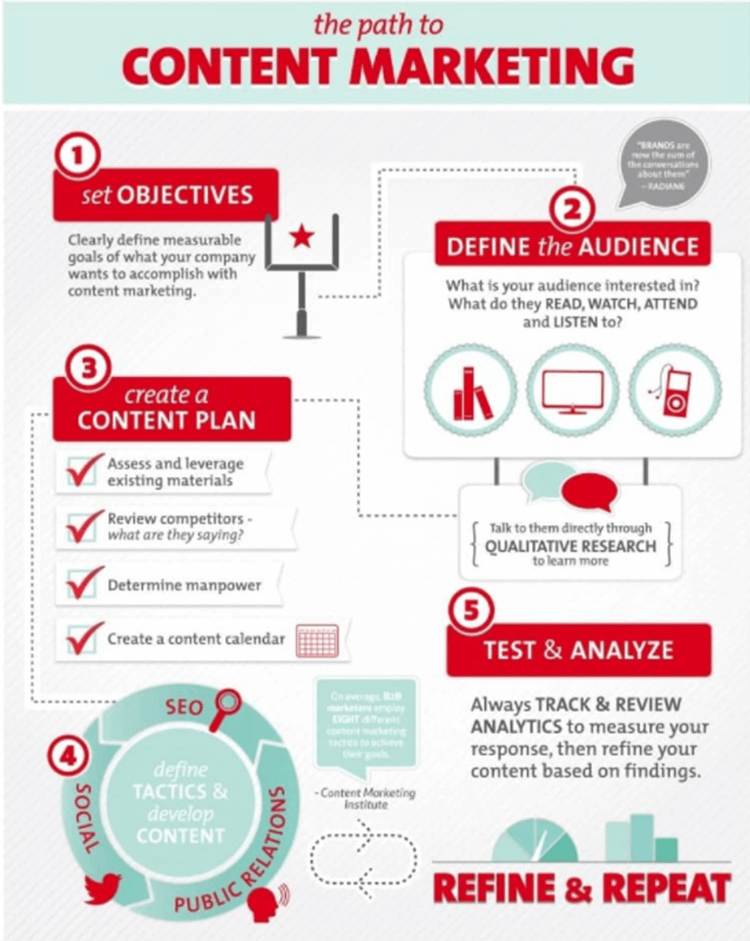
Guest Blogging:
✓ Can be a great way to get your content in front of new audiences.
✓ It's an additional or alternative method of increasing organic traffic to your site
✓ Increases your exposure to people that are interested in your products and services.
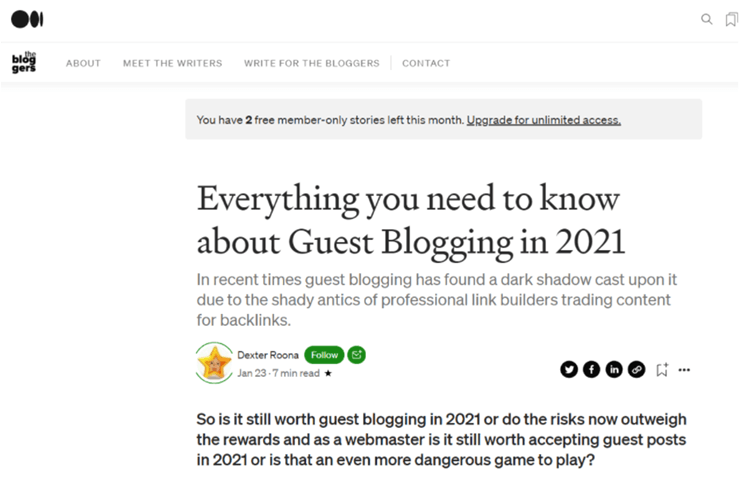
3. Set Your KPIs and Content Distribution Goals
Once you know your audience and what type of content will work best for them, set some goals you want to reach with each channel. KPIs (key performance indicators) include things like how many likes, shares, comments or other metrics are realistic to expect in a given amount of time.
If you have a large email list of customers you're already getting good engagement from (such as open rates higher than 30 percent), then the primary goal might be attracting 1,000 people to sign up for your newsletter over the next month instead.
Give each KPI an amount of time it would realistically take to achieve if you were to focus on that one particular channel. Then, once those targets are reached (or close enough you feel you can still get there in time), integrate similar goals for your other channels as well.
4. Create a Content Calendar
Now that you have your goals built out, it's time to fill in the dates and create an outline for how much content you'll be sharing on each channel over a specific period of time.
By doing this, you can avoid posting too much at once (and then getting burnt out without any motivation to keep going), or not enough (leaving your audience waiting with bated breath for new material).
The right amount will depend on what your KPI goals are for each month; aim to post quality over quantity when possible, but don't slack off if it means missing an opportunity or letting down your readership.
When putting together a content calendar, consider writing out a rough idea first of what types of things you'll want to share (the content types we covered before) and then start filling in the dates as far as what will be posted where.
Try to keep a mix of recurring posts, timely ideas that you might not have planned out ahead of time but still want to get out there, and fun extras that your audience has come to expect from you.
5. Create & Distribute Your Content.
Now it's time to create your high-quality content. Take your time to do this as your personal brand depends on the actions you take in this step.
After this is done, you need to implement the distribution strategy you have in mind. This step is where your new distribution strategy can begin.
For most channels, you'll probably need to put aside a specific time each day - or multiple times per week (depending on the content type and length), as well as set aside blocks of time for creating content other times during the month.
Other things to keep in mind:
✓ Always start with top-quality content that feels like it's worth people's time. If you take one idea from this article, make sure it’s this one.
✓ Mix up your style over time so that readers won’t be bored by what they see from you every day. Use different types of headlines, play with mediums across platforms, and level up your writing skills with every post you add.
✓ Write frequently enough that people will see new stuff, but don't get so caught up in posting that you don't have time to write anything of quality.
6. Measure and Analyze Your Results.
Finally, after all your hard work creating content, it's time to see what you got out of it. Depending on the type of content distribution channel you used, whether owned, earned or paid, results and analytics will be different.
If your goal was to increase views on a certain topic over some time via guest posting, then you can check that you hit those targets at the end of each month or quarter by tracking how many views each article received in Google Analytics.
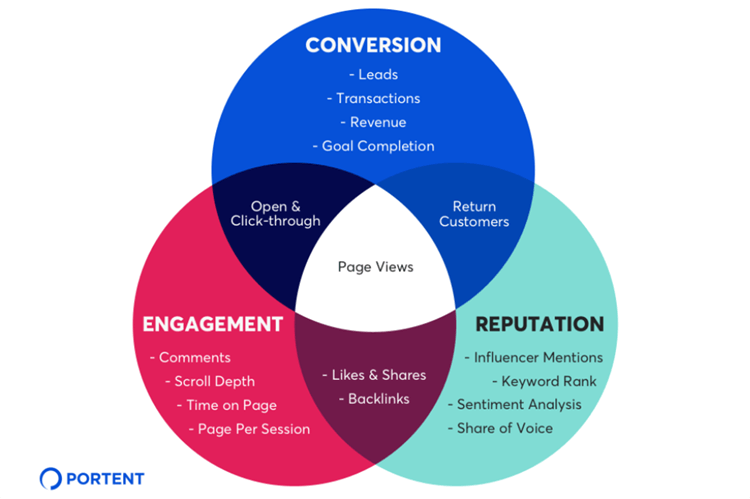
Looking at views, time on page, and bounce rates will allow you to understand what’s working and what’s not. This will also give you a plan of action to take when it comes to what comes next.
Other channels like social media may not offer as much granular insight into performance across such short periods - especially if you're working with multiple people at once - where analytics are more useful for larger chunks of time (e.g., looking back at but also going forward into the future).
In addition to such goals, consider setting other metrics for measuring success. Depending on your business goals - or even just what you want out of this content strategy in general.
Social media metrics could be as simple as several comments or social media engagement, or more extensive ones including increasing leads or sales with each piece you publish. Measure whatever makes sense for your brand so that next time you'll know exactly what works and what doesn't when going forward.
7. Keep Omni-channel Marketing in Mind
Omni-channel marketing holds great importance in this day and age. This simply means the integration of various channels to communicate with your target audience.
Today’s brands need to be able to create content for whichever channel makes the most sense for them while also being able to measure results in real-time and adapt as necessary.
From owned platforms such as an e-commerce site or retail location to earned sites like influencer posts, guest blog posts on other blogs or even social media posts done by your social media manager, there are many opportunities for self-marketing.
Content formats are an important part of omni-channel marketing. In reality, it means that you can create a piece of content that is then distributed across the appropriate media.
Conclusion
To summarise, whether you have an idea for a lifestyle business or have been operating for many years, content distribution is an important part of your overall marketing strategy. This gives you the tools to increase business growth through higher traffic and brand visibility.
Content comes in a lot of different formats, catering to various channels and vehicles.
Ideally, you should be focusing on content that can be created once and then used multiple times in different ways.
All this content should also lead back to your website so that viewers can directly find the product or service they're looking for. After all, that is the main aim of content distribution.
Interactive Templates
300+ Editable Drag & Drop Templates
Author
Hanson Cheng is the founder of Freedom to Ascend. He empowers online entrepreneurs and business owners to 10x their business and become financially independent. You can connect with him here.

